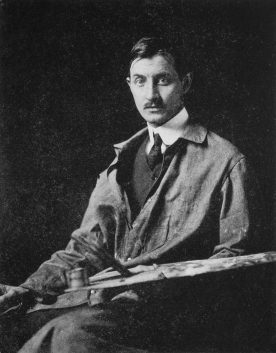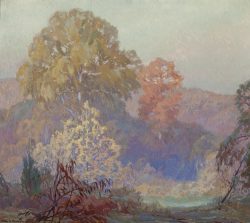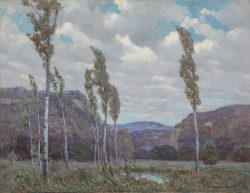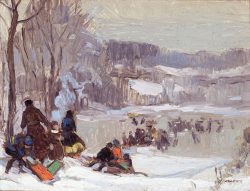Carl Krafft, from a photograph reproduced in Lena McCauley, “A Painter Poet of the Ozarks,” Fine Arts Journal 34 (Oct. 1916).

Carl Krafft 1884–1938
Carl Rudolph Krafft was born in Reading, Ohio, but grew up in Chicago, where his father was a Lutheran pastor on the city’s South Side. Krafft planned to follow his father and two of his brothers into the ministry; an accomplished organist, he also considered a career in music. Ultimately choosing to pursue his interest in art, he served an apprenticeship in a commercial art studio while attending evening classes at the Art Institute of Chicago; he also studied at the Chicago Academy of Fine Arts (founded in 1902). Represented by two landscape paintings, Krafft made his debut in the Art Institute’s “Chicago and Vicinity” exhibition in 1912. The following year, he joined Rudolph Ingerle and August Petrtyl, fellow Palette and Chisel Club members with whom he shared a studio, on a painting excursion to the Ozark Mountains in Missouri. A founding member of the Society of Ozark Painters, Krafft served as its president in 1915. That year, his work was featured in the Panama-Pacific International Exposition in San Francisco.
Krafft’s Ozark landscapes, lyrical exaltations of what he called his “cathedral of nature,” were well received.i In 1916 the Municipal Art League of Chicago purchased The Charms of the Ozarks (circa 1916; Union League Club of Chicago), and Krafft was hailed as the “painter poet of the Ozarks” in an admiring feature article in the Chicago-based Fine Arts Journal. Subsequently he won other significant honors, including the Logan Medal in the Art Institute’s “Chicago and Vicinity” exhibition in 1920 and a gold medal in the Allied Artists of America show in New York five years later. In 1920 Krafft received a solo exhibition at the Art Institute. Around that time he began working along the Mississippi River, painting industrial scenes and monumental character studies of longshoremen inspired by the figure paintings of Eugene Savage and Leon Kroll. Closer to home, he found landscape subjects in the forest preserve of Cook County west of the city. He taught outdoor painting classes for the Art Institute in the Palos area and later conducted his own landscape painting school at Willow Springs. Krafft also painted portraits, beginning in the late 1920s.
Around that time, Krafft abandoned the moody tonal effects of his early work for strong color contrasts and decorative brushwork, evolving a mature landscape style characterized by a powerful graphic sensibility. Often signing his canvases with his thumbprint as well as signature, he became renowned for his winter scenes. In 1927 Krafft moved with his family from Chicago to suburban Oak Park, where six years earlier he had helped establish the Austin, Oak Park and River Forest Art League (now the Oak Park Art League), serving as its first president. Notwithstanding his critical success, Krafft found himself in difficult financial circumstances during the Great Depression. In 1935, he was described as having recently suffered a nervous breakdown and he ceased to exhibit. Krafft died in Oak Park at age fifty-four. More than four decades later, his daughter Lal (Gladys Krafft) Davies published a memoir of him.
Wendy Greenhouse, PhD
i C. J. Bulliet, “Artists of Chicago Past and Present. No. 38: Carl Rudolph Krafft,” Chicago Daily News, Nov. 9, 1935.


